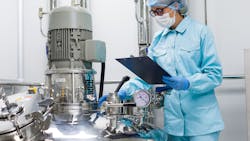Ease-of-use and efficiency bring radar to chemical processing
One of the newest applications for radar level measurement technology is chemicals processing. Following the natural evolution from maritime oil shipping to oil tank storage, the chemical processing industry is reaping the benefits of radar, mainly due to its need for a non-contacting solution. In addition, the lower cost of radar technology has made it more viable for chemical processing.
Chemicals play a vast role in our daily lives. “You can imagine how diverse the space is,” says Jenny Leion, chemical solutions manager for Emerson.
The plethora of products produced in various forms makes radar technology an ideal solution for the various substances that are stored, mixed and processed. “That’s one of the challenges, to be able to measure all of them, but that’s where non-contacting radar technology is really good because it is independent of density changes and steam and so on, so it still measures the surface really well,” she says. “Then for chemicals, as for many industries, the focus today is sustainability, of course.”
She says that among the challenges the chemicals processing sector faces, reducing waste and adding safety are paramount, and both non-contacting and guided wave radar technology as well as the point level detectors address those needs. “We are very tied to safety since level measurement is often used as a safety precaution, so you don’t have overfill and risk of spill,” Leion says.
Just as the oil industries in which radar technology saw its first commercial use, accurate level measurement is necessary to protect against detrimental spillage. In the case of chemicals, the result can be even more damaging given the hazardous nature of many of the formulations.
And, for waste reduction? “You can reduce waste by measuring variables and optimizing your process,” she adds, noting the continuous monitoring capabilities of radar versus mechanical means of the past.
“Coming from the chemical industry, I’ve seen many cases of both. You’re standing as an operator measuring from above with a tape measure, and that’s of course not great for safety for your operators,” Leion says. “For chemical, we have legacy technologies such as displacers and ultrasonic measurements that have their issues. With the new technology advances, radar has become a more affordable choice to be able to go into more applications than it did before. Previously, it was costly, but now with the latest radar technology, it’s much more affordable and can reach more applications.”
Leion says customers in the chemical space utilize both guided wave and non-contacting radar from Emerson depending on the type of application. Sometimes, users want to measure both level and interface level. Guided wave radar can accomplish it. “I think that’s a very cool technology that can measure two layers of a liquid with the same radar,” she says.
Non-contacting radar is ideal for when the instrument should not touch whatever is inside a tank.
Ideal use in chemical applications
The development of non-contacting and guided wave radar for industrial usage through the years has been a path from solving the issue of how to measure with radar on tanker ships, then coming to land and being able to measure accurately on tank farms and then, moving forward, to the general process industry and not the least the chemical industry
“Now, we have also had a development with frequency modulated continuous wave technology, and come from a four-wire to a two-wire device, this meant a step change in performance for non-contacting radar, where you had a wave that came back with a lot more information continuously than the pulse radar,” Leion says.
“Following the release of our FMCW two-wired technology, what we saw in the chemical industry was that there’s also a need for ease-of-use,” she continues. “In response to this need, we worked to digitize the capabilities of the products to align with our customers’ expectations and ultimately offer an easier to use device.”
She points to the Rosemount 3408 transmitter, saying that when you install the device, the ability to leverage Bluetooth-enabled technology creates the opportunity for operators to easily connect via a phone or tablet. This technology also helps operators with safety because no one has to climb tanks. “You can stand on the ground or in the control room and do the configuration there. And you have a graphical interface that’s much easier than it used to be, so you basically see if you do anything wrong.”
This evolution puts radar technology at a usability and cost-efficiency place where the chemical industry is able to fully embrace it.
Stepping into chemicals
With the broad market opportunities for chemical industries, Emerson is evolving its radar technology to fit the challenges those markets face. Some of those emerging markets involve agrichemicals, such as fertilizers and pesticides. In the current climate, chemicals for the agriculture sector are a growing opportunity and the diminishing costs for radar technology have helped that sector embrace the technology.
Leion adds that Emerson has established a new portfolio for the water and waste water sector as well. She says it will be interesting to see how sites with chemical processing plants and wastewater facilities match radar technologies from that one portfolio.
There are many applications for radar within chemical processing and they continue to evolve. Leion and Emerson are ready to tackle the next application on the horizon.
About the Author

Leaders relevant to this article:

